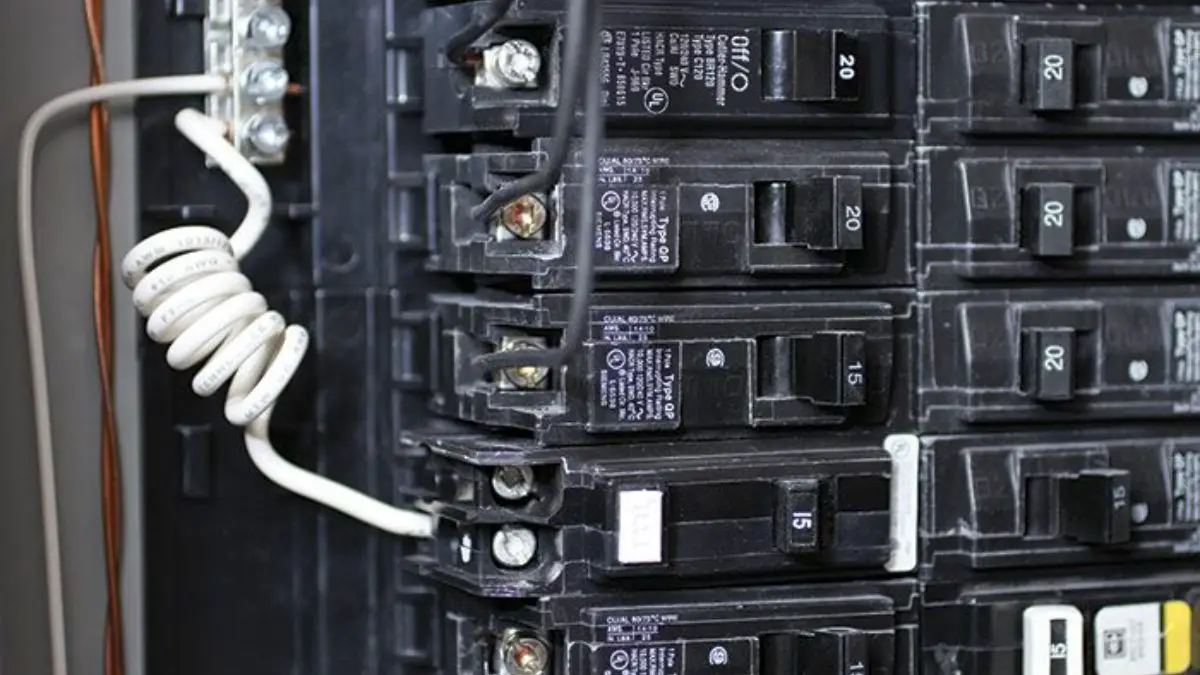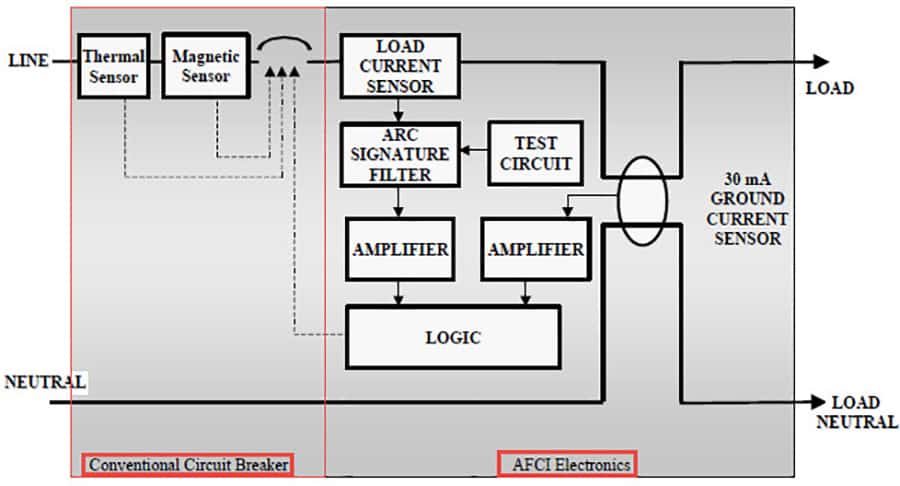Home protection and safety are some of the most critical aspects for any homeowner, as this can save both your home and the lives of your loved ones.
Electricity and electrical devices can be as dangerous as they are helpful. When it comes to fire hazards, many advances have been made in electrical safety in recent years. In 1999, the NEC included arc fault circuit interrupters in the electrical code. These interrupters help prevent electrical fires and have become more used.
How do arc fault breakers work? Arc Fault Breakers monitor the electrical circuit for signs of electrical arc faults. The arc fault breaker detects arc faults and quickly cuts power to prevent fires.
To understand how AFCI circuits work, it’s important to know about electrical arcs and their dangers.
So, let’s take a look at how arc fault circuits work.

How Do Arc Fault Breakers Protect Your Home?
An AFCI, which stands for Arc Fault Circuit Interrupter, is a device that keeps our homes safe by stopping arc faults. Arc faults can be dangerous, so the AFCI stops them from happening.
In 2011, over 47,700 home fires began due to electrical problems, as reported by the National Fire Protection Association. The Consumer Product Safety Commission says an AFCI can stop over 50% of electrical fires.
The AFCIs have more numbers in their favor. But first, let’s understand what an arc fault is. It often causes electrical fires.
What Is an Arc Fault?
An arc fault is a spark that can happen between two conductors or wiring connections.
For example, this can occur when the conductors (or wires) have damaged, frayed, or worn insulation. If the insulation is damaged, electricity can travel through the air and create an electrical arc fault.
Have you ever heard hissing or popping noises coming out of your outlets?
This can be a good sign of a possible tiny electrical arc happening every time you use your outlet. It would help if you addressed it immediately, as electrical arc faults are hazardous. If that happens, have a certified electrician check the outlet and replace it if needed.
Sometimes, a loose wiring connection can make a hissing or popping sound. This is called a “backstab” wire connection because it can cause arc faults.
What Makes Electrical Arc Faults Dangerous?
Arc faults are very dangerous as they generate heat.
The electrical current in the air turns some energy into very hot heat, over 10,000 F.
As a comparison, the temperature at the surface of the Sun is about 10,000 F, too.
This high temperature can melt and ignite anything that is in close contact.
Using the example above, if you unscrew the hissing outlet, you might see signs of arcing, like burning areas on the plastic or the wiring.
The damage to the outlet and old wiring is a fire waiting to happen, and this is how many electrical fires start.
Proper protection with an arc fault breaker is vital to our homes’ safety. It will cut out the electricity before reaching such high temperatures and causing physical damage.
How Does an Arc-Fault Circuit Interrupter Work?

AFCIs work by “listening” to the power line for any signs of an arcing happening.
The arc fault breaker has a sensor that detects electrical arcs. The arcs are usually around 100 kHz and last longer than a few milliseconds.
A combination AFCI breaker protects overload protection and short circuit protection caused by:
- parallel arcing (line to neutral)
- series arcing (a loose, broken, or otherwise high-resistance segment in a single line)
- ground arcing (from the line, or neutral, to ground)
If an arc fault breaker or a combination arc fault breaker senses a dangerous arc fault, it will stop the electrical current in the circuit.
Electrical arcs can happen when you use switches, tools with brushed motors, or plugs. Some arcs are dangerous. Usually, the newer AFCIs can distinguish between the two and know when to act.
The way AFCI works depends on its type. Over the years, different types of AFCI breakers have been introduced.
AFCI receptacles and breakers both have electronic parts that detect dangerous electrical arcs. The AFCI receptacle is installed on the first outlet of the branch circuit wiring. It protects all the receptacles downstream on that same branch circuit.
Unlike AFCI breakers, you may use AFCI receptacles on any wiring system regardless of the electrical panel.
What Are the Different Types of AFCI?
Since the NEC mandated AFCIs, they have improved for home safety efficiency and added new features.
In homes, there are different kinds of AFCI based on when they were built or renovated.
1. Branch Feeder Type AFCI Breakers
The branch feeder type is the oldest representative of the AFCI breakers.
These provide moderate protection as they can detect only parallel with the load arcs like:
- line-to-ground
- line-to-neutral.
The NEC made them mandatory in 1999. They were phased out starting in 2008 and are no longer used. Combination type AFCIs have taken their place.
2. Combination AFCI Breakers
A combination AFCI breaker does not mean it offers GFCI protection.
The combination AFCI breaker is different from the branch feeder type. It can find and protect against parallel and series arcing. This is an electrical arc created along the same conductor or wire.
This means that Combination AFCI can detect and protect from all three kinds of arcing:
- parallel arcing (line to neutral)
- series arcing (a loose, broken, or otherwise high-resistance segment in a single line)
- ground arcing (from the line, or neutral, to ground)
Series arcing means that the electrical arc continues along the same conductor or wire, making an arc somewhere along the line. Parallel arcing occurs when electricity escapes one conductor and travels along another.
You can consider the combination type of AFCI breakers the most used ones as they provide a convenient way to protect your home. An AFCI breaker will allow for installing GFCI outlets down the line.
3. Dual-Function Circuit Breakers
They protect against arc and ground faults – effectively combining the functions of AFCI with a GFCI.
The electrical code keeps changing and its requirements increase with each revision. We knew it would happen eventually. These will likely be used for future housing construction.
They combine AFCI and GFCI breakers, offering optimal protection for our homes. They also save us money and time.
4. AFCI Outlets

You can find AFCI outlets in some older homes.
AFCI receptacles do offer arc fault protection. As mentioned earlier, the AFCI receptacle safeguards itself and any connected receptacles. You must install the AFCI receptacle on the load circuit.
This can be tricky in older houses as some circuits serve rooms.
Another difference is that AFCI breakers will often cut power to the entire room, including lights. AFCI receptacles may not do this if the lights are not on the same circuit or downstream from the AFCI receptacle.
For a combination type AFCI breaker to work, the circuit neutrals need to be separated. This might not be the case with older dwelling places, where a combination type of an AFCI receptacle is the better option.
What Are the Common Causes for Arc Faults?
Knowing the most frequent reasons for an arc fault is the first step in making our home a safer place to live in. An arc fault can be caused by:
- Damaged or worn wire insulation.
- Connected wires.
- Static electricity.
- Arc faults in electrical circuits in close proximity.
- Faulty tools and electrical appliances.
- Worn, dirty, and poorly maintained circuit breakers.
- Liquids near electrical tools.
- Exposed live parts, and more.
An arc fault can happen in many different ways. For example, a screw or a nail behind the wall can damage the wire’s insulation. This is why AFCIs are vital, as they will protect our homes from potentially hazardous effects.
A working AFCI will immediately trip and protect you and your home by shutting down the power when any of these happen.
But, AFCIs can sometimes trip without a clear reason. At one time, this was a frequent issue for many homeowners and electricians, as well – this is something known as nuisance tripping.
What Is Nuisance Tripping, and Why Does It Matter?
AFCIs used to have a big problem called nuisance tripping. This happened when the breaker would trip a lot without a clear reason.
What can cause nuisance tripping:
- Bad wiring practices or improper electrical wiring.
- Incompatible electrical devices
- Faulty electrical devices.
- Old AFCIs
If your AFCIs keep tripping without reason, this should be immediately addressed and inspected, as this is a dangerous situation that you should never ignore.
Nowadays, devices and machinery have improved AFCIs’ ability to detect unintentional and intentional arcs. Besides that, today’s electrical equipment is better at not creating such fluctuations that would cause an AFCI to trip.
If you think you may need an electrical panel upgrade, our article Signs Your Electric Panel Needs an Upgrade: Safety & Costs to Replace may help.
How to Test if an Afci is Working
You should test the AFCI breakers every month to ensure they work and provide adequate protection to our homes.
You can do this in a few steps:
- Carry out the test while the power is on. Unplug any devices plugged in the electrical circuit to avoid any potential damage during a test. Make sure to disconnect any computers, laptops, and mobile phones, especially.
- Go to the electrical panel.
- While the breaker is in the ON position, press the Test button.
- Pressing the Test button will cause the breaker to trip. It should go to either the Trip position or the OFF position.
- If the button trips the breaker, it means it is working. For the sake of the test, you can try to plug in a table lamp to check if electricity is flowing in the circuit.
- You can switch it back to ON now.
Using the Test button is the best way to test an AFCI breaker. If the breaker doesn’t trip, a certified electrician must change it immediately because it has gone bad.
There are various AFCI testers and indicators that some people might use. Still, the manufacturers are usually not recommended and do not always work on all brands of breakers.
Where Are AFCIs Required?
Since 1999, the requirements for AFCIs have increased with each code revision. They now cover more rooms and areas in homes.
First, they installed them in bedrooms to protect against electrical blanket fires, but that has changed ever since.
We used arc fault circuits to detect loose wire connections to the receptacles.
The NEC requires the installation of appropriate arc fault protection in any room with 120 volts 15 to 20-ampere branch circuits.
Arc fault protection is usually not required in bathrooms, garages, and outdoor or external areas. Keep in mind, though, that these all need to have GFCI protection installed.
You need to install AFCI protection in:
- Kitchens.
- Dining rooms.
- Family rooms.
- Libraries.
- Dens.
- Bedrooms.
- Closets.
- Laundry areas.
- Parlors.
- Sunrooms, and more.
The Difference Between Arc Fault, Short Circuit, and Ground Fault
The terminology can get confusing. Especially for people who are not tech-savvy, terms like ground fault, arc fault, short circuit, and more can sound very intimidating.
But, these three are the most common terms that you can mix up sometimes as they may seem like the same thing, yet they are not.
Differentiate them; they pose a different hazard and cause them. Because of that, they need different safety measures to provide your home with adequate protection.
Let’s take a look:
1. Short Circuit
A short circuit is when the current flow goes through an unintended path with very low or no electrical impedance.
For example, the standard short circuit term refers to when the wire carrying the electrical current comes into contact with a neutral wire. Because the wires carry different voltages, there is little resistance, allowing a high current to pass through.
This is very dangerous as it can cause sparks, flames, and more.
2. Arc Fault
We can consider an arc fault as a type of short circuit. When you have a loose connection or corroded wires, an electrical arc can generate high amounts of heat.
An arc fault usually will not be detected by a GFCI or the standard circuit breakers, leaving your home vulnerable.
3. Ground Fault
A ground fault can also be considered as a type of short circuit. In this instance, the electrical current comes into contact with a grounded object. This can be anything that will allow the flow of electricity to travel to the earth as short of a distance as possible, even a human body.
Ground faults are so dangerous, as they can lead to fatal consequences.
Can a GFCI Substitute an AFCI?
A standard AFCI is not designed to protect against ground faults, and GFCIs are not designed to protect against arc faults.
It is vital to follow the NEC requirements to protect your home properly. The NEC would require both GFCI and AFCI protection in some cases.
This is usually done by installing a combination AFCI breaker and having GFCI-equipped receptacles down the circuit.
A GFCI cannot substitute an AFCI or vice versa, but AFCI and GFCI can be combined.
The AFCI breakers we discussed earlier can provide the best protection against ground and arc faults.
Usually, AFCIs and GFCIs can’t be swapped out. But now, some new receptacles and breakers have both GFCI and AFCI protection.
Dual-function outlets can save us money and time, so we don’t need to worry about the complex improper installation of breakers and outlets. At the same time, they still provide us with a much-needed layer of protection against electrical fires and ground faults.
Arc Fault Breakers FAQs
What is an arc fault on a breaker?
An arc fault on a breaker panel is an unintended electrical current arc that can cause intense heat and fires. It happens when wiring or devices are damaged or have loose connections. Unlike overloads and short circuits, arc faults can ignite surrounding materials.
Are arc fault breakers really necessary?
Yes, arc fault breakers, or Arc Fault Circuit Interrupters (AFCIs), are necessary in modern electrical safety standards. They provide a level of protection that traditional type of circuit breaker do not.
Where are you required to have arc fault breakers?
The requirements for AFCI breakers depend on whether the local area has adopted the National Electrical Code (NEC). From 2020 onwards, the NEC mandates AFCI protection in bedrooms, kitchens, and offices. To ensure you get the right information, check local rules or ask an electrician. Rules can be different.
Where are arc fault breakers required in 2023?
To find out the requirements for 2023, check the 2023 NEC when it’s published or ask a local building department or licensed electrician who knows the current codes in your area. Local codes are crucial because they allow different areas to adopt the NEC at their own pace.
Final Thoughts
Arc Fault Circuit Interrupters (AFCIs) are a crucial safety feature in modern homes, providing a necessary shield against the hidden dangers of arc faults that can lead to fires. By detecting and interrupting dangerous arcs, AFCIs enhance our electrical systems’ safety, complementing other protective devices like GFCIs.
Ensuring these breakers are properly installed and maintained is key to safeguarding our homes against electrical fire risks. As electrical standards evolve, the significance of AFCIs continues to grow, underscoring their role in keeping our living environments secure.







